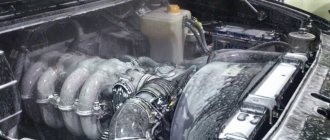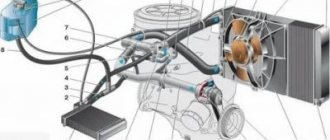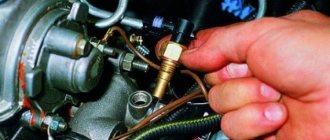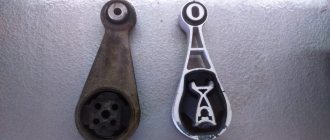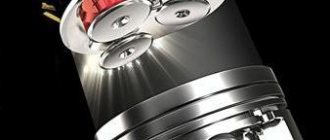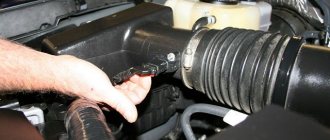(09/03/13) Daniil I recently purchased a VAZ 2170 (Priora) and overall I’m quite pleased with everything. But if you stop without turning off the engine, the temperature sensor shows 98, or even 100ºС. The same thing happens when driving in first and second speed. What should you do in this situation?
First of all, you need to find out what the operating temperature of the engine is, and what it is for the VAZ 2170. The car’s engine is equipped with a cooling system, inside which coolant circulates. The temperature of this fluid is the working temperature for the engine and is measured by a special sensor, and information about its value is displayed on the dashboard. What operating temperature of the Priora engine is considered average? When driving at a speed of 80 km/h, in a normally loaded vehicle and with environmental conditions not exceeding 20ºC, the coolant temperature is 95ºC. When the liquid heats up to 102ºС, the fan turns on, providing additional cooling. Thus, you have no reason to worry - your car's power plant is working normally. Overheating will be indicated by the indicator needle entering the red part of the scale.
It happens that the temperature sensor is faulty. What are the symptoms of engine overheating and what should you pay attention to:
- if in winter warm air suddenly stops flowing into the cabin, then perhaps the level of coolant in the power unit has dropped and it has stopped flowing into the heater;
- black puffs of smoke from the exhaust pipe and knocking may indicate detonation of the internal combustion engine, which can also be caused by its overheating;
- a sharp drop in engine power.
Most drivers, when overheating, immediately stop the car and turn off the engine. In fact, immediate stopping of the engine is necessary only in one case - if the cooling system has depressurized and its liquid is pouring out. In all other situations, the driver’s actions must be as follows:
- Turning on the interior heating at maximum power. Due to this, the fluid temperature will drop and the engine will begin to cool faster.
- Having turned on the emergency lights and depressed the clutch, try to smoothly roll to the side of the road or leave the roadway altogether.
- Let the engine idle for a couple more minutes without turning off the heating system.
After stopping the engine completely, you need to let it cool for 20-30 minutes (depending on the ambient temperature), after which you can measure the coolant level and, if necessary, add antifreeze to the cooling system.
Do not open the radiator cap immediately after stopping the engine! The liquid in it is under pressure and can cause serious burns. If for some reason the plug of a still hot radiator needs to be unscrewed, then it must first be wrapped in a thick rag in several layers. Further actions depend on the cause of the overheating and whether it can be eliminated on site or whether it is necessary to contact service.
A car engine is equipped with a cooling system that contains liquid. The temperature of this liquid is measured by a sensor. This value that it records is the engine operating temperature (ERT). The data recorded by the sensor is displayed on the dashboard. The average operating temperature of a Priora car engine is 95 degrees. This indicator is optimal when the car is moving at a speed of approximately 70-80 km/h and provided that the ambient temperature is not higher than +20 degrees. When the liquid heats up to 100 degrees, the fan turns on, which is designed for additional cooling. With such indicators, it is time to say that the power plant of the machine is functioning without failures. In winter and summer, the RTD may be different. Which RTD is considered optimal for this car? The average is 85-90 degrees.
What is the operating temperature of the Lada Priora engine?
A car engine is equipped with a cooling system that contains liquid. The temperature of this liquid is measured by a sensor. This value that it records is the engine operating temperature (ERT). The data recorded by the sensor is displayed on the dashboard. The average operating temperature of a Priora car engine is 95 degrees. This indicator is optimal when the car is moving at a speed of approximately 70-80 km/h and provided that the ambient temperature is not higher than +20 degrees. When the liquid heats up to 100 degrees, the fan turns on, which is designed for additional cooling. With such indicators, it is time to say that the power plant of the machine is functioning without failures. In winter and summer, the RTD may be different. Which RTD is considered optimal for this car? The average is 85-90 degrees.
Rated operating temperature of the VAZ 21126 Priora engine
Temperature sensor Lada Priora
This contributes to the normal correct operation of the power system, maximum engine performance, and in addition, the content of harmful substances in the exhaust gases complies with Euro3 standards that were current at that time. And the engine power, as practice shows, remains within the nameplate limits - about 98 forces at 5.5-5.6 thousand rpm. Again, judging by the reviews, and based on practice, fuel consumption during overheating can increase by 15-25%, and when operating the engine at coolant temperatures below 85 degrees, consumption increases by 10-18%.
If the fan does not turn on
If the RTD has risen to 100 degrees and the indicator needle has entered the red part of the scale, this indicates overheating. Perhaps this phenomenon occurred due to the fact that the fan did not work. If you find that when it overheats, the fan does not start working and the temperature does not drop, you need to check the serviceability of the fan itself. It is necessary to determine whether the switch-on sensor is triggered when the normal RTD is exceeded? First, start the engine and disconnect the wires from the temperature sensor that is installed on the engine. When the wires are disconnected, forced cooling should work. If this does not happen, most likely the fault lies in the electric motor of the device. How to check the operation of the fan, watch the video.
If the fan turns on after disconnecting the wires, it means there is a problem with the fan switch sensor. Perhaps it incorrectly perceives data about the RTD and therefore does not operate at the right time.
This malfunction is quite easy to fix: you just need to replace the sensor. After replacing it, check if the fan turns on. To do this, start the engine. When the RTD reaches normal levels, do not turn off the engine until the temperature exceeds the norm. As soon as this happens, the fan should be activated. If the fan operates at a temperature above 97 degrees, but less than 100 degrees, then the system is functioning properly.
Temperature sensor malfunction
The reason that the liquid in the cooling system, which serves as an air conditioner for the car's power plant, does not heat up or overheats is due to the failure of the temperature sensor.
Often signs of such a malfunction are:
- Stopping the flow of warm air into the car interior, which occurs due to the cessation of fluid flow into the heater.
- Dark, almost black smoke comes out of the exhaust pipe. This indicates engine detonation, which was a result of overheating.
- Engine power drops sharply.
Many drivers quickly stop the car when it overheats and turn off the engine. In fact, an immediate stop of the machine is required only if the tightness of the system is broken and liquid pours out of it
out. In other situations, the driver must perform the following actions:
- turn on the heating to maximum so that the fluid temperature drops and the engine cools down quickly;
- drive smoothly to the side of the road;
- Let the engine idle for 2-3 minutes with the heating system on.
After this, the engine must be turned off and allowed to cool for 20 minutes. After this, you need to measure the fluid level in the cooling system and add it if necessary. Immediately after the engine is turned off, you cannot open the radiator cap, as you can get burned from contact with the liquid. If the fluid level is normal, then the cause of overheating must be determined by diagnostics. To do this you will have to visit a car service center.
Source
Priora temperature sensor. How to check
Consequently, all responsibility for turning on the fan, and, consequently, adjusting the operating temperature, lies with the sensor. Its design is simple. This is an ordinary temperature sensor, which, when the temperature changes, changes the strength of the supplied response pulse. This is what the characteristics of the engine temperature sensor for VAZ 21126 Priora and Kalina look like:
Liquid temperature, °C
Naturally, as the temperature changes, the sensor voltage will also change.
Liquid temperature, °C
Method for checking the fan switching temperature sensor of Priora, Kalina, VAZ 2110
Therefore, if you have a multimeter in your hands and some skills in working with it, you can easily check the temperature sensor. To do this, you need to know to what temperature it is heated (which is easy to find out with a simple thermometer), and take the readings of a multimeter. Now the question of how to find out the temperature at which the fan turns on on Priora, Kalina and VAZ 2110 with a 16-valve VAZ 21126 engine disappears, and you can also draw a simple conclusion.
Once the antifreeze temperature reaches 110˚C, the sensor resistance is about 133 ohms. At the same time, the ECM sends a signal to turn on the fan. When the sensor resistance is about 188 Ohms at a temperature of 97-98 °C, the fan automatically turns off.
Schematic diagram of connecting the fan switch sensor
Thus, we have found out the principle of operation of the cooling system fan of Priora and Kalina cars with a 16-valve VAZ 21126 engine, as well as indications of the normal temperature in the cooling system.
A car engine is equipped with a cooling system that contains liquid. The temperature of this liquid is measured by a sensor. This value that it records is the engine operating temperature (ERT). The data recorded by the sensor is displayed on the dashboard. The average operating temperature of a Priora car engine is 95 degrees. This indicator is optimal when the car is moving at a speed of approximately 70-80 km/h and provided that the ambient temperature is not higher than +20 degrees. When the liquid heats up to 100 degrees, the fan turns on, which is designed for additional cooling. With such indicators, it is time to say that the power plant of the machine is functioning without failures. In winter and summer, the RTD may be different. Which RTD is considered optimal for this car? The average is 85-90 degrees.
Device and features
The cooling system of the Priora internal combustion engine has a standard set of main components:
- radiator;
- thermostat;
- electric fan;
- water pump;
- heater;
- engine jacket;
- connecting hoses;
- expansion tank.
By circulating through the large and small circuits, the coolant prevents the engine from overheating, maintaining the desired temperature. Structurally, the cooling system of the Priora is simple and no different from other internal combustion engines with an injector, with the exception of small parts.
Radiator and forced cooling fan
They mainly serve to bring the working fluid to the optimal temperature for the functioning of the engine (the operating temperature of the Priora engine with 16 valves is 90–95 degrees). The predecessor of the Priora VAZ 2110 often installed a cooler made of copper alloys, but due to cheaper prices, designers switched to aluminum analogues.
The operation of the fan depends on the engine control unit.
It receives information from the DTOZH (this is a sensor that reads temperature readings) located in the water jacket of the power unit. If the permissible temperature values are exceeded, the control unit connects an electric fan to improve cooling efficiency. A faulty fan or clogged radiator can lead to a constant increase in optimal engine temperatures, which shortens the service life and can cause costly repairs.
Thermostat
Its task is to promptly open coolant access to a large circle of the engine cooling system (engine cooling system) after the engine reaches the optimal temperature. In simple terms, the thermostat allows you to quickly warm up the engine and regulates the operation of the entire system. During warming up, the thermostat valve is in the closed position, antifreeze does not flow through the large circuit (the radiator is not activated). As it warms up, the valve opens slightly under the influence of rising temperature, and antifreeze begins to move through the radiator along a larger circuit.
A thermostat malfunction can result in overheating of the power unit (if the valve is stuck closed) or, conversely, the operating temperature rises very slowly (when the valve is stuck in the open position). Overheating is much more dangerous. Beginners can identify this malfunction if the engine heats up all the time and the fan on the Priora is constantly running.
Pump (water pump) and heater
Without the first part, the coolant circulation circuit in the system is impossible. If the water pump is faulty, at best there will be a coolant leak from the system. In the worst case, the pump may jam, which will lead to a broken timing belt and subsequent problems, the solution of which will result in expensive repairs.
Characteristics and features of DTOZH on Priora
Many motorists confuse the DTOZH with a cabin or ambient temperature sensor, but this is completely wrong. The purpose of the DTOZH is to monitor the temperature of the refrigerant in the cooling system.
There are two regulators in Lada Priora cars:
As for the principle of operation, it is as follows. The main regulator is located in the thermostat housing, which allows for the highest pulse accuracy. Since the DTOZH in any case comes into contact with consumables, that is, antifreeze, it instantly detects changes in temperature and sends corresponding signals to the ECU. The latter, based on the information received, adjusts the operation of the engine and changes the composition of the air-fuel mixture. If there is no or too low level of consumable fluid in the system, the controller will provide incorrect data.
DTOZH for the pointer on the instrument panel
The operating principle of this sensor is to change the resistance when the internal element heats up. Passing through the indicator on the instrument panel, the current flows through a single wire to the device. And here the principle of induction in coils comes into play. Simply put, the higher the resistance, the more the needle on the indicator rises, due to the circulating currents in the coil located inside the indicator.
Possible malfunctions of the Priora coolant temperature display system
Most motorists, having discovered that the engine temperature gauge needle does not rise, believe that it is necessary to change the sensor. However, you should first make sure that this is the case. After all, there are several reasons for this state of the panel:
- Failure of the pointer on the instrument board.
- Break in the wiring.
- Direct failure of the sensor.
Therefore, it is better to conduct a small check on your own.
Location and serviceability check of DTOZH
This device is located directly above the Priora flywheel housing. The sensor is embedded in the engine block near the thermostat. It is connected to a single wire with a female connector. The test method for this device is very simple. And it has been used by drivers for a very long time. You need to do this:
- Turn on the ignition.
- Disconnect the connector from the sensor.
- Connect the wire to the block body.
If the DTOZH itself is faulty, the indicator arrow will rise to its highest position. But if no changes occur on the instrument panel, then the reason must be looked for elsewhere. Maybe the circuit is broken, the pointer is broken, or the whole combination.
How to replace the Priora coolant temperature sensor
This is a fairly simple operation. It is available to any driver.
Important! Many believe that this requires draining the coolant. But this is not necessary if you act quickly and skillfully. Otherwise, it’s better to drain it anyway. So. Just in case, drain the antifreeze. To do this, unscrew the cap in the radiator. It is located near the generator, below. And a plug-bolt in the engine block. First place the container under the bottom.
Features of cooling system malfunctions
The efficiency of the structure primarily depends on the level of antifreeze in the system and its condition (this liquid has a certain resource, usually up to three years or up to 50,000 km). The main sources of system malfunctions are the thermostat, radiator and electric fan, as well as the water pump, the principle of operation of which is described above.
The radiator most often becomes the source of antifreeze leakage. Accordingly, the liquid level in the system drops, and there is not enough of it for effective heat removal. The motor begins to overheat. It can also be clogged with garbage. And if water is used instead of antifreeze the old fashioned way, scale may form.
Flushing the cooling system of Lada Priora
It becomes dirty and clogged over time and intensity of use. Clogged SOD channels do not allow antifreeze to circulate freely, as a result, heat transfer is disrupted. The stove in the cabin begins to heat poorly, and meanwhile the engine constantly overheats. In these situations, the right solution would be to clean the cooling system. To do this, first of all you need to cool the engine.
The following is the procedure.
- Drain the coolant (not only from the radiator, but also from the engine jacket, by unscrewing the drain plug on the cylinder block).
- Fill the expansion tank with any suitable flushing fluid to the optimum level.
- Start the engine and let it idle for at least 15 minutes.
- Drain the used fluid.
Then, if necessary, the procedure is repeated. After flushing, all that remains is to fill in fresh antifreeze and remove the air lock from the system. If a more thorough flushing of the system is required, then there is nothing complicated here either. To do this, you will need a regular watering hose connected to the water supply. To flush the radiator, you need to disconnect the lower and upper pipes, insert them into the upper hose and turn on the water. All dirt and rust will come out of the bottom. To flush the engine jacket, you need to do the same steps, but the hose is inserted into the thermostat pipe.
The effectiveness of flushing the system largely depends on the product chosen as a flushing agent.
The simplest option is regular tap water. Add lemon juice to it. Carbonated drinks, such as cola, are also suitable. You can also buy special cleaning products for washing SOD in specialized stores.
Priora engine tuning
To improve the power performance of the Priora power unit, they resort to the following modifications:
- The receiver is installed.
- Exhaust pattern: 4-2-1.
- Throttle valve: 54 -56 mm.
- Sports camshaft.
- Modification of the cylinder head (cylinder head) by sawing.
- Lightweight valves.
- 440cc type injectors.
In addition to the considered method of transforming the power unit to increase dynamic performance, there are several more ways to tune a car of this model.
Hey guys! Yesterday I went to Stavropol and discovered a problem. Previously, everything was calm, the temperature in winter and summer was consistently 84-86 degrees and the valve worked extremely rarely. I thought that this was not normal, I changed the thermostat, the result did not change. Well, I went like that. And yesterday I stopped to smoke, I didn’t turn off the car, the air conditioner was working, as soon as the on-board vehicle started to move, the staff began to squeak about a possible overheating of the engine, the temperature on it showed 110 degrees. I compared it with the tidy - exactly 110. I can’t hear the valve (I don’t know if it was working). I drove slowly and went down the hill at idle, the temperature dropped to 96. Well, then it stayed in the range of 95-102. Once it jumped to 104 in a traffic jam on the way up and again dropped to 95-96. I arrived at my destination, checked the antifreeze - the level was normal, the plug was normal (no traces of rust, I recently changed it), I moved all the chips. In the on-board vehicle, I changed the valve response temperature from 105 to 102 (some crap, it doesn’t even seem to change anything). All the time the engine reached 102 degrees, turned on the valve and cooled down. In general, as a result, now when driving around the city (and at night too), the temperature is constantly in the range of 96-102, the valve is constantly almost threshing. Actually the question is: what the hell? Is this normal? Or what to watch? Thanks in advance. I completely forgot, it was all in the morning at about 10 o’clock, the air temperature outside was 32 degrees...
Comments 43
Her operating temperature is 102
It’s amazing to see the great minds dispensing advice here.
Guys, I conducted further investigation, so to speak. The pump is working properly, I checked the pressure from a thin tube to the expansion tank, at high speeds, the stream steadily gains pressure. I checked the thermostat by touch, at 85 it starts to open, I don’t know when it’s fully open, but at 102 degrees both thick hoses are hot. The plug holds the pressure, after a long time I turned off the engine and unscrewed the plug, it sputtered normally. By the way, the pump is a luzar, I didn’t want to install it. Fans in general, you’ll understand how they work, just now I looked with the air conditioner on, it heated up to 102, both valves turned on all the way and threshed right up to 87 degrees. Then he turned off the condenser and began to heat it further, heated it up to 103 (!) degrees, both turned on again and again fully, the engine continued to heat up to 105 degrees and dropped sharply to 99, at that moment the fans stopped and started again, dropping the temperature to 95 and turned off fully. In short, I’m generally at a loss as to what to do. What haunts me is that then, for the first time, the temperature rose to 110.
If the fan does not turn on
If the RTD has risen to 100 degrees and the indicator needle has entered the red part of the scale, this indicates overheating. Perhaps this phenomenon occurred due to the fact that the fan did not work. If you find that when it overheats, the fan does not start working and the temperature does not drop, you need to check the serviceability of the fan itself. It is necessary to determine whether the switch-on sensor is triggered when the normal RTD is exceeded? First, start the engine and disconnect the wires from the temperature sensor that is installed on the engine. When the wires are disconnected, forced cooling should work. If this does not happen, most likely the fault lies in the electric motor of the device. How to check the operation of the fan, watch the video.
If the fan turns on after disconnecting the wires, it means there is a problem with the fan switch sensor. Perhaps it incorrectly perceives data about the RTD and therefore does not operate at the right time.
This malfunction is quite easy to fix: you just need to replace the sensor. After replacing it, check if the fan turns on. To do this, start the engine. When the RTD reaches normal levels, do not turn off the engine until the temperature exceeds the norm. As soon as this happens, the fan should be activated. If the fan operates at a temperature above 97 degrees, but less than 100 degrees, then the system is functioning properly.
Refinement of the cooling system
Domestic cars are far from perfect, that's a fact. Lada Priora was no exception in this regard, having inherited many shortcomings from the legendary “ten”. One of them is an unfinished cooling system.
There are several ways to quickly and without financial costs modify the SOD on Priora.
- Installing a 6-hole thermostat (stable maintenance of coolant temperature).
- The use of Kalina SOD on Priora will reduce the pressure in the system and provide quick warm-up at subzero temperatures.
- Installing a larger or additional water pump to improve coolant circulation efficiency.
- Use of multi-speed and silent forced cooling fan.
- Changing the firmware of the control unit so that the fan operates at a lower temperature.
Refining the cooling system of the Lada Priora is a feasible task even for novice car enthusiasts. The SOD has a simple design with a minimal set of components. Thanks to this, the system is relatively reliable.
If the operating rules are followed, the ODS does not cause problems for the car owner, but natural wear of parts is possible. Therefore, it is necessary to regularly monitor the operation of the system and, if even minor problems are identified, correct them as soon as possible.
The VAZ 2170 model received several power plants, but the most popular engine in the Priora is a gasoline unit with 16 valves and a volume of 1.6 liters. On various automotive forums it is called briefly - 126 (number). Responsible drivers spend a long time thinking about which car to buy, and the engine plays an important role in this matter. Service life, operating temperature, price of a new motor, analysis - our review will answer all these questions.
When does the fan turn on on a VAZ 21126 and how does it affect engine performance?
Since the VAZ 21126 engine differs only slightly from the main VAZ 2110 (21124) engine, their operating temperature conditions are the same, this applies to all 16-valve VAZ engines. Another thing is that the driver in real time can assess the operating temperature conditions only by two indicators, and even then they are not very objective - this is the arrow of the liquid temperature indicator on the instrument panel and the moment the cooling system fan turns on.
Location of the temperature sensor, this sensor only works on the indicator on the dashboard
Obviously, you can’t tell much by looking at the arrow; its readings are more of a symbolic nature. But the fan on Priora and VAZ 2110 operates at a clearly set coolant temperature. The fact is that the engine control system (ECM) has more accurate temperature data than the driver. These are sensors located in the cylinder block, there are two of them.
One performs a purely decorative function and is responsible for reading the temperature indicator on the tidy. The second one is the main one. Visually, it differs in that two wires are connected to it, rather than one, and it is this wire that reports the actual antifreeze temperature to the ECM. It gives the unit accurate information and sends a command to turn on the fan.
The fan switch sensor is located near the thermostat, above the temperature indicator sensor
At the same time, the engine temperature drops by an average of 5-7 degrees if the Carlson is turned on at half power, and if with full load, the temperature levels out from 105-107 ˚C to a nominal 96-98 degrees, depending on the speed and temperature outside.
Rated operating temperature of the VAZ 21126 Priora engine
To find out what the normal operating temperature is in the Priora 16 class injection engine, just study the factory technical documentation. It says that according to the International Motor Vehicle Manufacturers Convention, the operating temperature in gasoline engines with an injection power system should be within 90 degrees. VAZ 21126 engine must operate in the temperature range from 87 to 103 degrees .
Temperature sensor Lada Priora
This contributes to the normal correct operation of the power system, maximum engine performance, and in addition, the content of harmful substances in the exhaust gases complies with Euro3 standards that were current at that time. And the engine power, as practice shows, remains within the nameplate limits - about 98 forces at 5.5-5.6 thousand rpm. Again, judging by the reviews, and based on practice, fuel consumption during overheating can increase by 15-25%, and when operating the engine at coolant temperatures below 85 degrees, consumption increases by 10-18%.
Work resource
The manufacturer states that the 126 by 16 valve engine can operate stably for 200 thousand kilometers. After this limit, the power plant requires major overhaul. But do not forget that AvtoVAZ is a real lottery; for some Priora owners, the engine caught a wedge at 2 thousand. But if you take care of your Lada car, regularly perform maintenance and replace damaged components, then you can safely count on a service life of 150-200 thousand km.
The resource of the power plant is influenced by many factors, here are some of them:
- Overheating . Running the engine on a Priora at elevated temperatures significantly reduces its service life. The operating temperature, which we will talk about in the next section, must be maintained at the same level.
- Fuel . The instruction manual indicates what kind of gasoline should be poured into engine number 126 with 16 valves. It is also recommended to visit only trusted gas stations that will not fill you with diluted fuel.
- Engine oil . Everything is simple here - change the lubricant in a timely manner and buy high-quality oils, then the service life will be 150-200 thousand km. For the 16 valve unit 126, semi-synthetics (Lada recommendation) and synthetics are suitable. The oil needs to be changed once a year or every 15 thousand kilometers; as you can see, the fluid does not have a long service life.
Engine disassembly and repair
Repairs are carried out according to the standard procedure - we find faulty parts and replace them with working ones. The instructions below describe the process of disassembling the unit itself; before that, you need to dismantle it from the Lada Priora and thoroughly clean it of grease and dirt.
From the tools we will need regular and ring wrenches, a ratchet with an extension, screwdrivers, a pry bar and a stand. It is best to carry out repairs in a garage with good lighting.
Instructions
- Using the 13th key, remove the bracket fastenings. 4 nuts hold the front cylinder block support;
- We remove the bracket and move on to the left support - it is removed in exactly the same way;
Thus, you can completely disassemble the 16-valve engine and repair and replace faulty parts. But if the unit bends the valve, then only an experienced mechanic can handle the malfunction with his own hands. In any case, you will find out whether the motor bends the valves or not after removing the head cover.
Guys, tell me, when driving at first, second speed and in traffic jams, the engine temperature quickly rises to 100, 107 degrees, when driving at high speed the temperature drops to 85 - 90? This is especially noticeable now, in the spring, the weather is warm. Is this normal? phenomenon? What will it be like in the summer at plus 40 degrees? Will I overheat the engine? Thank you all in advance!
Hi all! I recently bought a Lada Priora 1.6 16 cl. 2009 with air conditioning. The car is constantly heating up, the temperature is closer to 100°. I changed the pump and timing belt, at the same time drained the entire system (the plug option is excluded, I think), the thermostat was changed, the pipes are all hot.
Tell me what the reason is.
And another question, maybe someone had! I did a full diagnosis of the injector, the result: not a single error, engine operation is smooth, system pressure is 4, the gasoline filter has been changed. But the car doesn't pull anything? What could this be, what should I do?
Thank you all in advance) I’m already thinking about selling it!
Engine operating temperature
We have learned the resource, now we move on to another important indicator. The optimal operating temperature is 90-95°C. After 97°C, engine number 126 with 16 valves will “slow down” a little, but according to the rules, temperatures up to 100°C are considered normal. If the Lada unit is operated with this indicator, then you need to be sure that the radiator fan is running at this time. When you see an indicator below +90°C on the dashboard, you need to assume that this is underheating. Of course, in cold weather the power plant needs more time for the temperature to reach normal levels.
- Operating temperature – 90-95°C.
- Normal temperature (engine runs worse) is 97-110°C.
- Reduced temperature – 90°C and below.
Operating temperature of VAZ 21126 Priora engines
Not only the engine life, but also a number of other performance indicators depend on the operating temperature of the VAZ 21126 gasoline injection 16-valve engine. When the operating temperature is lower or higher than the nominal one, power and dynamics are lost; the temperature affects the operation of the heater and the quality of mixture formation. And this entails indicators on fuel consumption and engine life as a whole. Today we will figure out how to change the operating temperature of the Priora, Tens and Kalina 16 valve engine, what temperature is normal and how the cooling system fan affects engine operation.
Are the valves bent?
Each engine in a Lada Priora car bends a valve, this also applies to the most powerful unit number 126 by 16. They will tell you this in any service center that services domestic cars. But novice drivers should know that the engine bends components for a reason, and if you follow the operating rules, you will not encounter this problem.
The Lada power plant bends parts only if the routine work to replace the belt and other components of the gas distribution mechanism (GRM) is violated. The motor bends the valve if the rollers, belt or water pump were not replaced in time. When one of these elements breaks, the number 126 pistons meet the valves. Due to this design feature, the motor bends the parts. The solution to the problem is a major overhaul of the Lada.
see also
So, the task of the owner of a Lada Priora with engine number 126 for 16 cl is to check the timing belt in a timely manner.
The condition of the belt should be checked every 50 thousand kilometers (according to the factory recommendations - 100 thousand) - there should be no cracks, delaminations, or breaks on it. If they are present, the belt must be changed urgently. Mandatory repairs take place after 200 thousand kilometers.
The rollers and timing pump number 126 should also be given attention when inspecting the belt. After all, the engine bends parts even with faulty rollers. Sometimes the timing belt and its components wear out prematurely - you will know this by vibrations from the engine compartment and an unpleasant grinding noise. Engine number 126 bends the valve, so do not forget to change the timing components in time and repair this unit.
DIY replacement instructions
If the diagnostics showed that the DTOZH is operational, but signs of a malfunction still appear, then, as we have already said, check the quality of the regulator connection and wiring. If, as a result of the check, it turns out that the device is inoperative, then the coolant temperature sensor will need to be replaced. The replacement procedure itself is not particularly complicated; even a novice car enthusiast can handle it.
As you know, Lada Priora cars go on sale in several modifications - with an 8 or 16 valve engine. Therefore, some car owners may think that the replacement procedure will look different in both cases. But we immediately want to dispel doubts - everything will look almost identical - the thermostat housing is located in the same place on both versions of the engine. The only difference is that you will need to dismantle the line that connects the air filter element to the throttle in advance.
Temperature sensor malfunction
The reason that the liquid in the cooling system, which serves as an air conditioner for the car's power plant, does not heat up or overheats is due to the failure of the temperature sensor. Often signs of such a malfunction are:
Many drivers quickly stop the car when it overheats and turn off the engine. In fact, an immediate stop of the machine is required only if the tightness of the system is broken and liquid pours out of it
out. In other situations, the driver must perform the following actions:
How much does engine No. 126 cost?
As it turns out, buying a new 16-valve unit for a Lada Priora is an expensive proposition. Today you can purchase a 16 valve 1.6 liter EURO-3 and EURO-4 engine. The first option costs approximately 102 thousand rubles, and the second – 103 thousand. Motorists are also interested in how much it costs to purchase a used Lada unit. Used ones can be purchased even for 20 thousand rubles. But you can find out what condition this unit is in only after a complete disassembly or a trip to a car service center. The average price for a used one is 50-60 thousand rubles.
